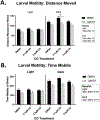Embryonic exposures to cadmium and PAHs cause long-term and interacting neurobehavioral effects in zebrafish
- PMID: 38452988
- PMCID: PMC10990771
- DOI: 10.1016/j.ntt.2024.107339
Embryonic exposures to cadmium and PAHs cause long-term and interacting neurobehavioral effects in zebrafish
Erratum in
-
Corrigendum to "Stickler A, Hawkey AB, Gondal A, Natarajan S, Mead M, Levin ED. Embryonic exposures to cadmium and PAHs cause long-term and interacting neurobehavioral effects in zebrafish" [Neurotoxicol Teratol. 2024 Mar-Apr;102:107339. doi: 10.1016/j.ntt.2024.107339. Epub 2024 Mar 6].Neurotoxicol Teratol. 2024 Nov-Dec;106:107405. doi: 10.1016/j.ntt.2024.107405. Epub 2024 Dec 4. Neurotoxicol Teratol. 2024. PMID: 39632165 No abstract available.
Abstract
Developmental exposure to either polycyclic aromatic hydrocarbons (PAHs) or heavy metals has been shown to cause persisting and overlapping neurobehavioral effects in animal models. However, interactions between these compounds have not been well characterized, despite their co-occurrence in a variety of environmental media. In two companion studies, we examined the effects of developmental exposure to cadmium (Cd) with or without co-exposure to prototypic PAHs benzo[a]pyrene (BaP, Exp. 1) or fluoranthene (FA, Exp. 2) using a developing zebrafish model. Zebrafish embryos were exposed to Cd (0-0.3 μM), BaP (0-3 μM), FA (0-1.0 μM), or binary Cd-PAH mixtures from 5 to 122 h post fertilization (hpf). In Exp. 1, Cd and BaP produced independent effects on an array of outcomes and interacting effects on specific outcomes. Notably, Cd-induced deficits in dark-induced locomotor stimulation were attenuated by BaP co-exposure in the larval motility test and BaP-induced hyperactivity was attenuated by Cd co-exposure in the adolescent novel tank test. Likewise, in Exp. 2, Cd and FA produced both independent and interacting effects. FA-induced increases on adult post-tap activity in the tap startle test were attenuated by co-exposure with Cd. On the predator avoidance test, FA- and 0.3 μM Cd-induced hyperactivity effects were attenuated by their co-exposure. Taken together, these data indicate that while the effects of Cd and these representative PAHs on zebrafish behavior were largely independent of one another, binary mixtures can produce sub-additive effects for some neurobehavioral outcomes and at certain ages. This research emphasizes the need for detailed risk assessments of mixtures containing contaminants of differing classes, and for clarity on the mechanisms which allow cross-class toxicant interactions to occur.
Keywords: Behavior; Benzo[a]pyrene; Cadmium; Developmental; Fluoranthene; Neurobehavioral; Zebrafish.
Copyright © 2024 Elsevier Inc. All rights reserved.
Conflict of interest statement
Declaration of competing interest The authors have no conflicts of interests for this article.
Figures




References
-
- Abd El Naby WSH, Zong C, Fergany A, Ekuban FA, Ahmed S, Reda Y, Sato H, Ichihara S, Kubota N, Yanagita S and Ichihara G, 2023. Exposure to Benzo [a] pyrene Decreases Noradrenergic and Serotonergic Axons in Hippocampus of Mouse Brain. International Journal of Molecular Sciences 24(12). - PMC - PubMed
-
- Azzolina NA, Kreitinger JP, Skorobogatov Y, & Shaw RK, 2016. Background concentrations of PAHs and metals in surface and subsurface soils collected throughout Manhattan, New York. Environmental Forensics 17(4), 294–310.
-
- Bensoussan H, Grancolas L, Dhieux-Lestaevel B, Delissen O, Vacher CM, Dublineau I, Voisin P, Gourmelon P, Taouis M and Lestaevel P, 2009. Heavy metal uranium affects the brain cholinergic system in rat following sub-chronic and chronic exposure. Toxicology 261(1–2), 59–67. - PubMed
MeSH terms
Substances
Grants and funding
LinkOut - more resources
Full Text Sources
Miscellaneous

